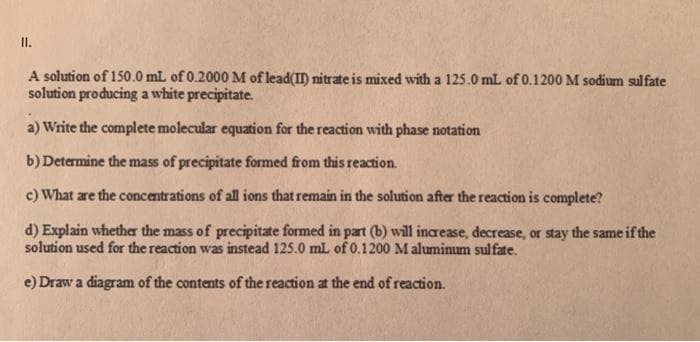A solution of 150.0 mL of 0.2000 M of lead(II) nitrate is mixed with a 125.0 mL of 0.1200 M sodium sulfate solution producing a white precipitate. a) Write the complete molecular equation for the reaction with phase notation b) Determine the mass of precipitate formed from this reaction. c) What are the concentrations of all ions that remain in the solution after the reaction is complete?
A solution of 150.0 mL of 0.2000 M of lead(II) nitrate is mixed with a 125.0 mL of 0.1200 M sodium sulfate solution producing a white precipitate. a) Write the complete molecular equation for the reaction with phase notation b) Determine the mass of precipitate formed from this reaction. c) What are the concentrations of all ions that remain in the solution after the reaction is complete?
Chapter4: Types Of Chemical Reactions And Solution Stoichiometry
Section: Chapter Questions
Problem 61E: A 100.0-mL aliquot of 0.200 M aqueous potassium hydroxide is mixed with 100.0 mL of 0.200 M aqueous...
Related questions
Question

Transcribed Image Text:II.
A solution of 150.0 mL of 0.2000 M of lead(II) nitrate is mixed with a 125.0 mL of 0.1200 M sodium sulfate
solution producing a white precipitate.
a) Write the complete molecular equation for the reaction with phase notation
b) Determine the mass of precipitate formed from this reaction.
c) What are the concentrations of all ions that remain in the solution after the reaction is complete?
d) Explain whether the mass of precipitate formed in part (b) will increase, decrease, or stay the same if the
solution used for the reaction was instead 125.0 mL of 0.1200 Maluminum sulfate.
e) Draw a diagram of the contents of the reaction at the end of reaction.
Expert Solution
This question has been solved!
Explore an expertly crafted, step-by-step solution for a thorough understanding of key concepts.
This is a popular solution!
Trending now
This is a popular solution!
Step by step
Solved in 5 steps

Knowledge Booster
Learn more about
Need a deep-dive on the concept behind this application? Look no further. Learn more about this topic, chemistry and related others by exploring similar questions and additional content below.Recommended textbooks for you


Chemistry
Chemistry
ISBN:
9781305957404
Author:
Steven S. Zumdahl, Susan A. Zumdahl, Donald J. DeCoste
Publisher:
Cengage Learning

Chemistry: An Atoms First Approach
Chemistry
ISBN:
9781305079243
Author:
Steven S. Zumdahl, Susan A. Zumdahl
Publisher:
Cengage Learning


Chemistry
Chemistry
ISBN:
9781305957404
Author:
Steven S. Zumdahl, Susan A. Zumdahl, Donald J. DeCoste
Publisher:
Cengage Learning

Chemistry: An Atoms First Approach
Chemistry
ISBN:
9781305079243
Author:
Steven S. Zumdahl, Susan A. Zumdahl
Publisher:
Cengage Learning

Chemistry: Matter and Change
Chemistry
ISBN:
9780078746376
Author:
Dinah Zike, Laurel Dingrando, Nicholas Hainen, Cheryl Wistrom
Publisher:
Glencoe/McGraw-Hill School Pub Co

Introductory Chemistry: A Foundation
Chemistry
ISBN:
9781337399425
Author:
Steven S. Zumdahl, Donald J. DeCoste
Publisher:
Cengage Learning

Introductory Chemistry: An Active Learning Approa…
Chemistry
ISBN:
9781305079250
Author:
Mark S. Cracolice, Ed Peters
Publisher:
Cengage Learning